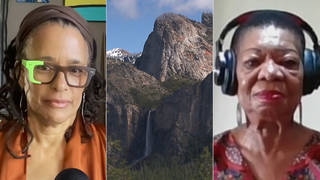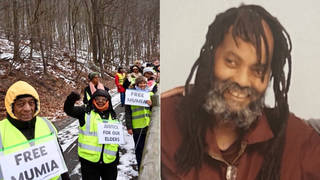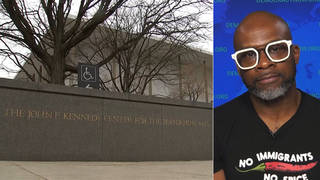
Guests
- Nellie McKayprofessor of American and Afro-American literature at the University of Wisconsin-Madison and the editor of the 2,600-page Norton Anthology of African American Literature.
In the history of the world’s great literature, few traditions have origins as remarkable as that created by African slaves and ex-slaves in the Americas. On Democracy Now!, we present a one-hour special on the rich and dazzling tradition of African American literature and culture, including a rare speech from James Baldwin and a fabulous presentation by Walter Mosley, the African American mystery writer.
Just this past month, a major new book was published: “The Norton Anthology of African American Literature,” a 2,600-page book of some 120 writers from 1746 to the present day. This literary treasure also contains 13 works in their entirety, including Frederick Douglass’s “Narrative of the Life of Frederick Douglass” and Gwendolyn Brooks’s “Maud Martha.”
Transcript
AMY GOODMAN: In the history of the world’s great literatures, few traditions have origins as remarkable as that created by African slaves and ex-slaves in the Americas. Today on Democracy Now!, we present a one-hour special on the right and dazzling tradition of African American literature and culture, including a rare speech by James Baldwin.
The Norton Anthologies are considered by many to represent the canon of literature in a particular field. Well, finally, after more than a decade in the making, there is a Norton Anthology of African American Literature. It was published this past month, a 2,600-page book of some 120 writers from 1746 until the present day. This literary treasure also contains 13 works in their entirety, including Frederick Douglass’s Narrative of the Life of Frederick Douglass and Gwendolyn Brooks’ Maud Martha.
Before we go to the co-editor of the anthology, I thought we’d begin with a song. It’s called “Rosie,” performed by inmates of the Parchman Farm penitentiary in Mississippi in 1947.
PARCHMAN FARM INMATES: Be my woman, gal, I’ll
Be your man
Be my woman, gal, I’ll
Be your man
Be my woman, gal, I’ll
Be your man
E’ry day’s sundown dollar
In your hand
In your hand, Lordy,
In your hand
E’ry day’s sundown dollar
In your hand
Stick to the promise, girl, that
You made me
Stick to the promise, girl, that
You made me
Stick to the promise, girl, that
You made me
AMY GOODMAN: The men who sang the song were prisoners, and only a few wanted to be identified, like C.B. Cook, Andrew Harris, Willie Heardon, Dan Butler, Clarence Alexander and six other Black men in prison stripes.
Well, right now we’re going to turn to the co-editor of The Norton Anthology of African American Literature. She’s professor Nellie McKay, and she’s a professor of American and Afro-American literature at the University of Wisconsin-Madison.
Why don’t we begin by you telling us about the origins of this project?
NELLIE McKAY: The idea for a Norton Anthology of African American Literature, that would, within its covers, contain a comprehensive survey of the African American literary tradition, the idea came from professor Henry Gates some 12 years ago or so. He was then at Cornell University and took the idea to the Norton Company. Norton was not all that enthusiastic about it, but they agreed to do some market surveys and to see whether it was a feasible idea. They spent almost two years doing the surveys.
AMY GOODMAN: Is this standard for an anthology?
NELLIE McKAY: I don’t know. We’ve never had to deal — I never had to deal with Norton before that. But I think that 12 years ago the idea of an anthology of African American literature was still not something that I think a press like Norton might have been enthusiastic about. They were concerned whether there were people who would be there to buy this book. It’s not like just putting a bunch of poetry together or even a bunch of short stories together. This was a book to be a textbook, to be used broadly, widely, in colleges and universities across the country and in foreign countries. And they were, to some extent, not sure that the time was right. So, I don’t think that the same problem would have existed when they put together The Norton Anthology of, say, British Literature or The Norton Anthology of American Literature, because I think those canons had, more or less, essentially, been already established. But no one had established a canon in African American literature up until that time. And so, after two years of their market surveys, where they discovered that, yes, they could do it, because it would — and they could expect that in two years they would be able to sell 12,000 copy, which was their break-even point, they thought. It made it a feasible experiment at least to try. And that decision was made in 1986.
AMY GOODMAN: Well, let’s talk about some of the people that you chose to put into this anthology, how you chose to start with the vernacular tradition, something that you don’t usually see in a Norton anthology — spirituals, gospel, the blues, and secular rhymes, jazz rap, sermons and folktales.
NELLIE McKAY: Well, we — those of us who were teaching African American literature and teaching surveys in African American literature at that time, we all were, people who were chosen to work on the anthology — had all been working in African American literature for at least 10 years ourselves. And most of us who taught the surveys always began our courses with the vernacular tradition. We always talked about the spirituals. We always talked about the work songs. We talked about the oral tradition because we knew that that was where it all began.
Writing had come to Africans in America very late. And, in fact, it wasn’t until after slavery that we find large numbers of Black people being able to read and write. What we knew was happening, however, long before people were reading and writing, was that, in fact, they were creating literature. They created it in their songs. They created it in the stories they told. They created it in the mythologies.
And some of those works were, in fact, collected in the 19th century and even as late as the early 20th century, before they were lost. And so we have that material. And we had used that material in our classes, and we knew about it, and we knew that it was the beginnings, the foundations, of the written literature. And so it wasn’t even a question of why should we put it in there. It just had to be there.
AMY GOODMAN: Then, in the next section, you have the literature of slavery and freedom, with people like Phillis Wheatley. Can you talk a little about this segment and Phillis Wheatley, Sojourner Truth, Harriet Jacobs?
NELLIE McKAY: Well, with the exception of Sojourner Truth, who could neither read nor write, the literature of slavery was done in writing by former slaves. None of them wrote exactly, except maybe Jupiter Hammon — wrote while they were slaves. They mostly wrote after they escaped from slavery. And they wrote because they wanted to tell the rest of the country, who did not know about how horrific slavery was. And also, because they wanted to prod the country into freeing the slaves, they wrote their stories. You notice that most of those stories are people telling the stories of their own lives, of what it was like to be in slavery and their hopes for freedom, not only for themselves, but for all Black people.
AMY GOODMAN: You have Frederick Douglass in this section, and this brings up another remarkable part of this book, which is that there are 13 major works included. That means whole books —
NELLIE McKAY: Yeah.
AMY GOODMAN: — like W.E.B. Du Bois’s Souls of Black Folk and Frederick Douglass’s Narrative of the Life of Frederick Douglass, an American Slave. Can you tell us about Frederick Douglass’s Narrative?
NELLIE McKAY: Now, Frederick Douglass’s text is one such text. We think it is a classic. It’s Frederick Douglass as a slave, in our contemporary language, has been called the sort of model for the slave or for the Black man in slavery, who was enslaved and then escaped his bonds. And that narrative is an extremely powerful narrative, in which Douglass, who had never had any formal education at all, shortly, a couple of years, after he — not a couple, it’s more than a couple — six years after he escaped from slavery, he was able to sit down and write his own life story. By that time, he had also been speaking quite a bit on the anti-slavery circuit, so he had the story down pat by then. And it is just one of the great texts.
AMY GOODMAN: We’re talking to professor Nellie McKay. She’s a professor at the University of Wisconsin, and she is co-editor of a most remarkable anthology, probably the most remarkable anthology I’ve ever seen, and it’s The Norton Anthology of African American Literature. Now, I have used examples of men, and I think another part — another aspect of this anthology that makes it so special is that of the 120 authors you include, more than 50 are women. Can you talk a little about Lorraine Hansberry’s A Raisin in the Sun?
NELLIE McKAY: Well, Lorraine Hansberry was the first woman to have her play done in the theater on Broadway in New York. She was a woman before her time, in fact. And her play was so powerful at the time that it was written and at the time it was seen on the stage. And she was addressing the central issue in American life, which is race relations between whites and Blacks and the ways in which Blacks have been deprived of very basic elements of humanity by the rest of the society.
Lorraine Hansberry was an intellectual, and she wrote this play from an intellectual’s standpoint. And like Du Bois, who was also one of her — not one of her teachers so much as one of the people whom she saw as her great models — like Du Bois, she was interested in being analytical and critical of the conditions of Black people — in this particular case, the conditions of just basic living, where people lived, how they lived and how they managed to survive in a society that tried to deprive them of the right to have a decent living.
She used the form of the play to show how Black men in America have been frustrated, over decades and centuries, because they had been shut out. And remembering that Hansberry’s play comes just about at the beginning of the civil rights movement, when things are beginning to heat up already, but it serves as a real marker of a new period and gives also to subsequent playwrights the model by which they can talk about some of the issues that she raises — in different ways, many of them, but also as poignantly as she does.
AMY GOODMAN: There is an audio companion with The Norton Anthology that includes people whose work you have in your book, like Paul Robeson.
NELLIE McKAY: Right.
AMY GOODMAN: In the CD, he’s performing “Go Down Moses.” And also, Zora Neale Hurston performing “You May Go But This Will Bring You Back.” Zora Neale Hurston, what did she offer unique to the African American canon, to American literature in general?
NELLIE McKAY: Yeah, Zora Neale Hurston is the beginning of the modern period. Up until the 1920s, African American literature is very much in the tradition of American literature, in the sense that some of the same criteria or the same criteria that would be used for selecting literature for American literature would also be used as African American literature, and that the models for writing the literature were usually European American and European models for writing literature. What we have with the period in which Zora Neale Hurston appears — and she begins to write in the 1920s; she’s doing short pieces, stories in the 1920s — what we have with her is a breakaway and the beginning of really trying to capture the Black voice in what I would like to loosely call Black forms. For instance, Hurston’s novel Their Eyes Were Watching God, which we have in our book, is a mixture of vernacular, Black vernacular, as well as standard English.
AMY GOODMAN: What you might call Ebonics?
NELLIE McKAY: Yeah, yeah, exactly. And she was the first of the women to do this, and to do it, actually, with a feminist heroine, which until that time just never existed in the literature. So she was a great foremother for Alice Walker and Toni Morrison and Gloria Naylor and all the many other writers who have come after her.
AMY GOODMAN: You end with Walter Mosley and Essex Hemphill.
NELLIE McKAY: I think Hemphill, who closes the book, in fact, is very important in that space, because, in my mind anyway, he died shortly — he died a couple of years ago of AIDS. And in the period in which we are now living, we know of AIDS as a scourge on our nation. We know of it as another way in which people’s lives have been oppressed. And death and suffering, much death and suffering, has come about because of the scourge of AIDS. I see ending with Hemphill very much bringing the book full circle, in the sense that it begins with slavery, which is the scourge of one group of people, and we end with a writer who himself dies of AIDS, which is the scourge not of one group of people, but of all Americans and all people, in fact, in many, very many parts of the world, so that, in my own mind, bringing the book full circle that way essentially speaks to the humanity of all of us and the commonness that we all share as human beings.
AMY GOODMAN: The Norton publishing company was concerned that there wouldn’t be enough — a large enough audience out there, of course, I guess, first assuming that it would be limited to the African American audience —
NELLIE McKAY: Exactly.
AMY GOODMAN: — and even there, that you wouldn’t have the audience. What has been the response? Have they managed to sell those 12,000 copies?
NELLIE McKAY: Well, in the first month that it was out, they sold 30,000 copies. And that’s — the joke is on Norton, actually, in all of this. But, you know, I also must say that this is the time for this book, as well. I don’t know in 1984 that anyone could have predicted how much, you know, we could sell at that time, the way we see it now. And I think that much has happened over the last 10 years. I think, partly, the book sells itself because it is such a wonderful book. And I say that even though I’m so intimately tied to it. It is a wonderful book, and I think, in many ways, it sells itself.
One of the things that is actually, for me, still inexplainable is: How is it that we sold 30,000 copies of this book before we sold a single copy to a student? Because that first 30,000 that were sold in December were not sold to students. They were sold to the general public. And that is an amazing feat. But I think it’s — there’s a time. The book had its time, has its time. And it is in its time.
AMY GOODMAN: Nellie McKay, a professor of American and Afro-American literature at the University of Wisconsin-Madison, and the co-editor of the 2,600-page Norton Anthology of African American Literature. You’re listening to Democracy Now! We’ll be back with James Baldwin in just a minute.













Media Options